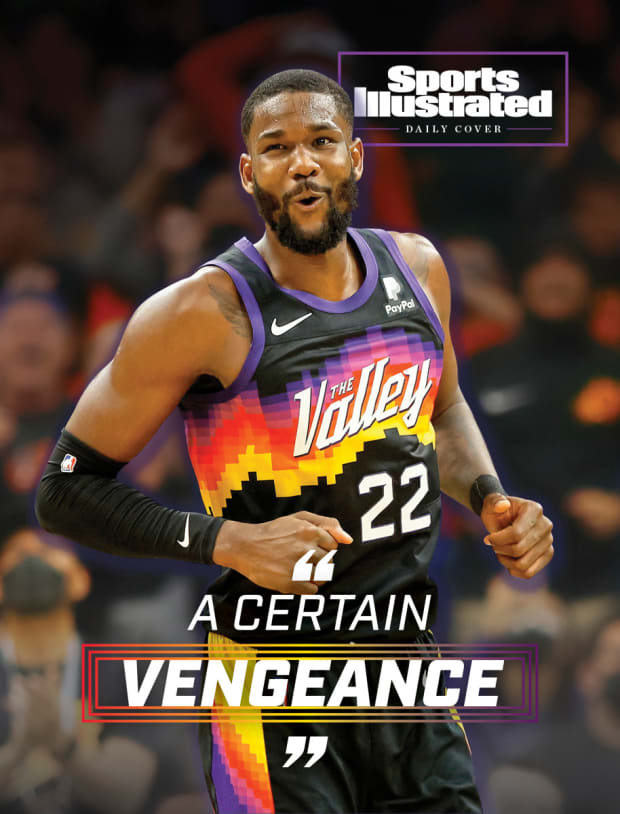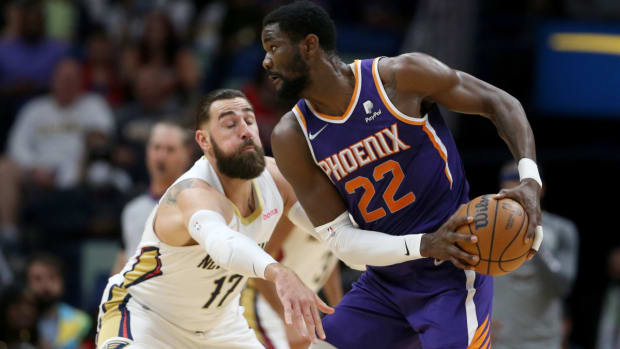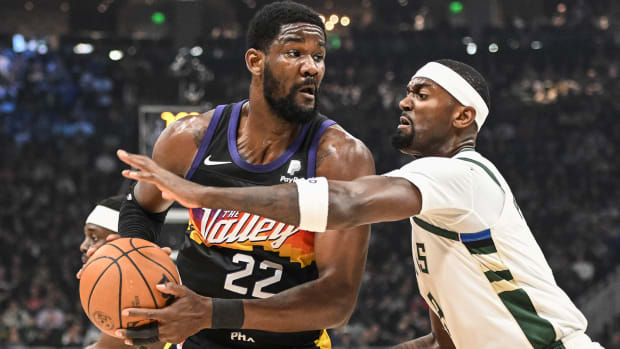In Game 1 of the Suns’ first-round matchup against the Pelicans, Deandre Ayton picked up right where he left off from his last appearance in the postseason. In a double-digit Phoenix win, Ayton scored 21 points on 10-for-15 shooting, adding nine rebounds and four blocks while anchoring the team’s stout defense. This kind of performance has become routine for Ayton, who averaged a 16 and 12 on 66% shooting for the Suns during their run to the Finals last summer—including 10 games in which he shot over 70%. And that taste of success has only emboldened Ayton as Phoenix looks to capture the championship that eluded them a season ago.
“I’m going to tell you the truth right now, that was the worst taste in our mouths,” Ayton told Sports Illustrated late in the regular season about last July’s loss to the Bucks. ”It’s like a knife stabbed us in the chest. I think about it every day. And there’s a certain vengeance I’ve been putting into my game.
“So lord knows we’re coming into this postseason ready.”

Christian Petersen/Getty Images
There was a time when the Suns weren’t always sure what to expect from Ayton. The former No. 1 pick briefly looked like the latest in a line of organizational follies—taken ahead of Trae Young and Luka Dončić in the 2018 draft. His career was filled with starts and stops—averaging a double double as a rookie, then earning a 25-game suspension for violating the league’s anti-drug policy in his second year. He would trade big nights for fourth quarters in which he wasn’t on the floor in crunch time. His play was anything but routine. And the smaller players picked after him were making a much bigger impact on their teams.
Amid Phoenix’s two-year renaissance, however—which unsurprisingly coincided with the arrival of Chris Paul—Ayton has become a key cog of the best team in the NBA and the favorite to win the Finals. On a team with two superstars in Paul and Devin Booker, Ayton has made himself indispensable to the Suns’ success.
“Every year has been a process, and he’s getting better every year,” says Suns assistant Mark Bryant, a former 15-year vet who has worked closely with Ayton since joining Monty Williams’s staff in 2019. This season Ayton averaged 17.2 points and 10.2 rebounds a night on a career-best 63.4% field goal percentage. While the numbers aren’t eye-popping on the surface, what they don’t show is Ayton has turned himself into a complete center.
“Last year, I didn’t feel like I was a threat,” Ayton says. “Teams weren’t really worried about me unless I was rolling. This year I really wanted to work on my short rolls and beating switches. The game is more open to me, and I get to where I want to get.”

Chuck Cook/USA TODAY Sports
Ayton took what he learned from the playoffs and applied it to what he wanted to accomplish this season. After realizing teams were going to do their best to negate his hard dives to the rim, he had to add counters to his game. That meant working with Bryant for hours after practice on jump hooks, floaters, sealing smalls in the paint and his 17-foot jumper. And the result is Ayton turning into much more than just a lob catcher.
Ayton was already a devastating force on pick-and-rolls. Of all players who were the roll man on at least three screen-and-rolls a night in the regular season, Ayton was third behind only multiple-time All-Stars Rudy Gobert and Domantas Sabonis in efficiency, averaging 1.25 points per possession—beating out MVP candidates like Joel Embiid and Nikola Jokić. The numbers show his work elsewhere has paid off.
- Of all players who averaged at least 3.5 elbow touches a night, Ayton was second in field-goal percentage when he caught the ball in that space, ahead of explosive scorers like Karl-Anthony Towns and Kevin Durant.
- Of all players who attempted at least three shots in the nonrestricted area of the paint—floater territory—Ayton was third in field-goal percentage, ahead of paint dwellers Giannis Antetokounmpo and Dončić. (He also ranked ninth of all players with at least four attempts a game in the restricted area, ahead of Embiid and Jokić.)
- And from midrange, Ayton converted 45.2% of his looks, ahead of wing juggernauts like Jayson Tatum and Donovan Mitchell.
- For good measure, Ayton also averaged more points per possession on post ups than Giannis, Towns, Anthony Davis and Bam Adebayo, to name a few gifted bigs.
Ayton used to be the kind of center who would roll hard seemingly to get out of the way. Now—though he may not be the kind of big you throw the ball to on the block and ask for a score—he’s a threat to score wherever he catches the ball. While many centers have their flaws magnified in the playoffs, Ayton’s versatility becomes an asset.
“He knows his spots. He knows how to get his,” says Suns guard Cam Payne, who runs his fair share of actions with Ayton. “He don’t miss shots because he’s taking the shots that he works on every day. We really call him the Mid Man, because his midrange game has improved. And when he bangs around the basket you can count it.”

So much of Ayton’s success undeniably comes from playing with Paul, perhaps the league’s premier pick-and-roll maestro. Paul has made a career of turning his big men into unstoppable forces near the hoop. But Ayton’s ability to finish from other spots of the floor separates him from rim runners like DeAndre Jordan and Clint Capela. And this season, albeit in a brief stint, Ayton proved he could thrive without Paul as well.
From the end of the All-Star break through March 23, Paul missed every game due to a hand injury. With Paul out, Suns coach Monty Williams told Ayton he wanted him to play “like a grown man” in every facet of his game. And in that time with Paul sidelined, Ayton actually shot better from the restricted area, nonrestricted area paint and midrange. As much as Paul drives his centers’ success, Ayton’s screen setting and touch carries over no matter who is on the floor.
Bryant credits much of Ayton’s improvement in that area to his guards. Paul and Booker worked closely with Ayton throughout last season, constantly getting in his ear to fine tune what he was doing in pick-and-rolls. The time spent with the elite ball handlers paid off to the point where Ayton can be successful even if he’s working with someone less heralded in Payne.
“He knows when to get behind the defense for a lob, he knows when to stay in the pocket for a floater, he always knows how to find that window,” Payne says. He adds that Ayton is adept at working to the advantages of the specific guard he’s setting a pick for. “Especially with me because I’m so fast, he’s in the pocket because I love taking off. It just messes up defenders, because they don’t know whether to be up or stay back. He’s becoming smarter in that area and it’s making it easier to score.”
“Playing with one of the best point guards in the world gave me the confidence to show him like, yo, I can do this with anybody, you know what I’m saying?” Ayton says. “He taught me enough to where I can set the same pick-and-roll—obviously it’s not the same point guard—with anybody.”
While Ayton clearly spent time in the gym to round out his offensive repertoire, the experience he gained during Phoenix’s Finals run also played a major role in his improvement. During the postseason, DA held his own against the likes of Anthony Davis, Jokić and Antetokounmpo—on both ends of the floor.
A significant part of what makes Ayton such a valuable big in today’s NBA is the different roles he can fulfill defensively. He can drop and protect the paint, deterring guards from challenging him inside. He can hedge out onto wing players all the way out beyond the arc. And he can take on the best players at his position with reasonable success individually.
According to NBA.com’s matchup stats, Ayton restricted a hobbled Anthony Davis to only 37.5% shooting during the Suns’ first-round series against the Lakers last year. He then held Jokic to 42.2% shooting when he was guarding the MVP in last year’s playoffs. On plays with Ayton defending the Joker, the Nuggets averaged only 0.97 points per possession. After the series, Jokić credited Ayton as being one of the best in the league at slowing him down individually. Ayton even had success during Giannis’s explosion in the Finals, holding him to 50.7% shooting—6.2 points lower than his postseason average. (Ayton was a plus-nine overall in that series.)
“You can put DA in anything,” says Bryant. “You can put him up on a screen and he can move his feet. You can switch. He can do anything you want him to do. That helps us where we can change our defense. There’s not too many guys like that. He’s so athletic you can put him in any situation and he’ll thrive in it.”
Athleticism is not the only key to Ayton’s play on the defensive end. He says the biggest difference between himself now and early in his career is he knows his defensive coverages “like the back of his hand,” and he prepares every night for the other team’s bread and butter. Bryant says Ayton is locked in mentally, constantly peppering him with questions about opposing offenses and taking it upon himself to get ready for his opponent’s tendencies.
“DA really knows the game,” Bryant says. “When it comes to the game, he’s ready to take care of business. He wants to know his assignments. Does he need to know more? Yes. But he has really learned the game since we’ve been here.”

Benny Sieu/USA TODAY Sports
Ayton’s evolution and selfless play has come against the backdrop of an uncertain contract situation. He is set to become a restricted free agent this summer, creating a 21st-century dilemma for the Suns. How much do you value a center who doesn’t create his own shot, especially when that center has the benefit of playing with a Hall of Fame point guard? So far, Ayton has proved about every way he possibly can he’s not only eating off the plates of others. And that effort is not lost on his teammates.
“I’m ecstatic. I’m turnt for him,” Payne says. “Because myself, I understand that one year you have to show everything that you got. To see DA doing it, with everything that he’s been going through with the contract, just always staying ready and being able to perform at a high level. I can’t wait to see him get his next deal.”
The last person who seems to worry about the contract situation is Ayton himself, who said early in the season he put the negotiation behind him as soon as the extension deadline passed. If Ayton is secretly sweating the offseason, you could never tell from his demeanor. When he’s not leaving it all on the floor, you’re more likely to see Ayton dancing than worried about his contract.
(Seriously! Arguably the highlight of the Suns’ season was watching Ayton, Payne and Mikal Bridges have a mini lip-sync battle to YoungBoy Never Broke Again’s slime tone “Nevada” before a 30-point drubbing of the Blazers in early March. Ayton even picked up one of the floor mops to use as a faux microphone before passing it around to his teammates. Says Payne: “For the most part, I pick the songs. Normally, we don’t really have YoungBoy in the playlist. One day in the group message they said let’s switch the songs up. Instead of mainstream songs, songs we actually listen to in the locker room. DA likes YoungBoy so we had to make sure we played it.”)
For now, Ayton’s motivation is about washing the taste out of his mouth left by the Suns’ bitter defeat at the hands of the Bucks. His work before the season was largely motivated by all the little things he wished he did better in the Finals. Even though Ayton says his confidence “went through the damn roof” after the run Phoenix had a year ago, he’s channeled all that energy into wanting to leave his mark on the Suns’ success.
“I’m trying to show people they ain’t on my level,” Ayton says. “I don’t know how to stop playing hard or stop my sense of urgency. 110% is all I know now coming out of the Finals.”
The Suns still have quite a long way to go before avenging last year’s loss. If they do end up making it back to the championship round, they can count on Ayton to be ready to be a major reason for why they have a chance to finish the job.







